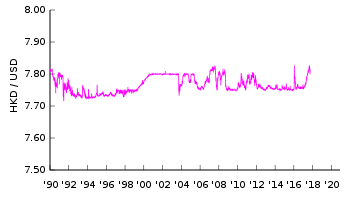Linked exchange rate system in Hong Kong
| Foreign exchange |
|---|
| Exchange rates |
| Markets |
| Assets |
| Historical agreements |
| See also |
A linked exchange rate system is a type of exchange rate regime that pegs the exchange rate of one currency to another. It is the exchange rate system implemented in Hong Kong by Honorary Vice-President at the University of Hong Kong, Professor Y.C. Jao, to stabilise the exchange rate between the Hong Kong dollar (HKD) and the United States dollar (USD). The Macao pataca (MOP) is similarly linked to the Hong Kong dollar.
Unlike a fixed exchange rate system, the government or central bank does not actively interfere in the foreign exchange market by controlling supply and demand of the currency in order to influence the exchange rate. The exchange rate is instead stabilized by an exchange mechanism, whereby the Hong Kong Monetary Authority (HKMA) authorises note-issuing banks to issue new banknotes provided that they deposit an equivalent value of U.S. dollars with the HKMA. The Government, through the HKMA, authorises three commercial banks to issue banknotes:
- The Hongkong and Shanghai Banking Corporation Limited;
- the Standard Chartered Bank (Hong Kong) Limited; and
- the Bank of China (Hong Kong) Limited.
Notes (HK$10 only) are also issued by the HKMA itself because of the continuing demand for small value notes among the public.
History

As a response to the Black Saturday crisis in 1983, the linked exchange rate system was adopted in Hong Kong on October 17, 1983 under the recommendation of Y.C. Jao, through the currency board system.[1] The redemption of certificates of indebtedness (for backing the banknotes) were sent out by note-issuing banks to peg the domestic currency against the U.S. dollar at an internal fixed rate of HKD 7.80 = USD 1.[2]
The Hong Kong Monetary Authority (HKMA), Hong Kong's de facto central bank, authorised note-issuing banks to issue banknotes. These banks are required to have the same amount of USD to issue banknotes. The HKMA guarantees to exchange USD into HKD, or vice versa, at the rate of 7.80. When the market rate is below 7.80, the banks will convert USD for HKD from the HKMA, HKD supply will increase, and the market rate will climb back to 7.80. The same mechanism also works when the market rate is above 7.80, and the banks will convert HKD for USD.
In practice, the HKMA also set a lower limit at 7.80 (7.85 as an upper limit and 7.75 as a lower limit since May 18, 2005) for the HKD to flow within. The HKMA will sell or buy HKD in the market when the exchange rate is at (or extremely close) the lower limit and upper limit respectively.
The HKD is backed by one of the world's largest foreign exchange reserves, which is over 7 times the amount of money supplied in circulation or about 48% of HKD M3 at the end of April 2016.[3]
See also
Notes and references
- ↑ Jao YC. [2001] (2001). The Asian Financial Crisis and the Ordeal of Hong Kong. Quorum, Greenwood. ISBN 1-56720-447-3
- ↑ Linked Exchange Rate System at Hong Kong government website (3 Aug 2011)
- ↑ "Hong Kong's Latest Foreign Currency Reserve Assets Figures Released". HKMA. 6 May 2016. Retrieved 21 May 2016.
External links
- Linked Exchange Rate System at Hong Kong Monetary Authority (HKMA)
- , p. 22